Femtosecond Pulse Compressors
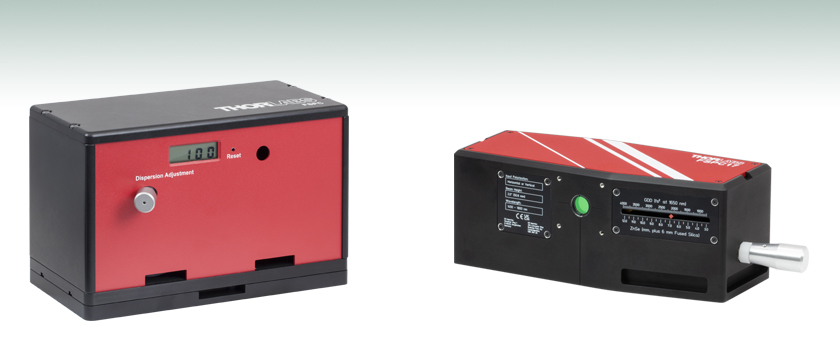
- Maximize Image Contrast from Multiphoton Microscopes
- Designed for Multiphoton Imaging Lasers
- Adjustable Compensation for Wavelengths from 700 to 1050 nm or 1450 to 1800 nm
FSPC
Femtosecond Pulse Compressor for 700 to 1050 nm Pulses
FSPC17
Femtosecond Pulse Compressor for 1450 to 1800 nm Pulses
(Shown With Base Plate Installed)

Please Wait
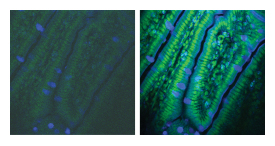
Click to Enlarge
Figure 1.1 The left image shows a sample without dispersion compensation. The right image shows the sample with dispersion compensation, resulting in a shorter pulse and higher contrast.
Features
- Pulse Compressors for 700 nm to 1050 nm or 1450 nm to 1800 nm
- Designed for Two-Photon or Three-Photon Imaging Lasers
- Adjustable Dispersion Range:
- Item # FSPC: -12 500 to 0 fs2 (at 800 nm)
- Item # FSPC17: +750 to +4000 fs2 (at 1650 nm)
Thorlabs' Femtosecond Pulse Compressors help correct for the pulse width broadening that occurs in multiphoton microscopes. As shown by the sample images in Figure 1.1, pulse width broadening can lead to significantly decreased image contrast in multiphoton microscopy.
Multiphoton microscopes like Thorlabs' Bergamo® III rely upon femtosecond lasers that emit near-infrared pulses with durations of roughly 100 fs. In order to be short in duration, the pulses consist of a broad range of wavelengths.
Ideally, the pulse width at the sample would be as short as the pulse emitted by the laser. However, when propagating through the optical elements in the microscope (such as fluorescence filters, dichroic mirrors, scan lenses, and objectives*), the pulse width broadens: each wavelength travels at a different velocity because the glasses' indices of refraction vary as a function of wavelength. In contrast, when propagating through air, the pulse width is conserved: all wavelengths within the pulse effectively travel together because air's index of refraction is relatively constant as a function of wavelength.
This broadening phenomenon, known as group delay dispersion (GDD), is detailed in the Group Delay tab. The femtosecond pulse compressors compensate for GDD imparted by the microscope on the laser pulse, ensuring that the pulse arriving at the sample is as short as possible, thereby maintaining high contrast. Typically, negative GDD compensation is needed for multiphoton excitation pulses below 1500 nm and positive GDD compensation is needed for pulses above 1500 nm.
* See P. E. Hänninen and S. W. Hell, Bioimaging 2, 117 (1994); M. Müller, J. Squier, and G. J. Brakenhoff, Opt. Lett. 20, 1038 (1995); G. J. Brakenhoff, M. Müller, and J. Squier, J. Microsc. 179, 253 (1995); J. B. Guild, C. Xu, and W. W. Webb, Appl. Opt. 36, 397 (1997); and M. Müller, J. Squier, R. Wolleschensky, U. Simon, and G. J. Brakenhoff, J. Microsc. 191, 141 (1997).
These plots show the net transmission and GDD precompensation of the FSPC Femtosecond Pulse Compressor.
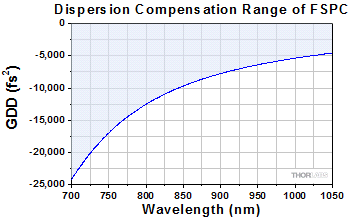
Click to Enlarge
The shaded region in this plot denotes the precompensation values that the Femtosecond Pulse Compressor can provide.
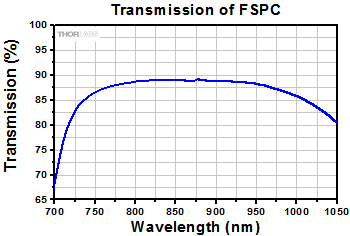
Click to Enlarge
This plot shows the calculated transmission of the Femtosecond Pulse Compressor.
h
These plots show the calculated net transmission, the GDD precompensation, and the reflectance of the ZnSe prism and C-coated window interfaces of the FSPC17 Femtosecond Pulse Compressor.
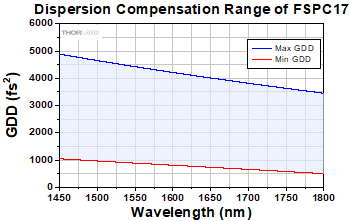
Click to Enlarge
Click Here for Data
The shaded region in this plot denotes the precompensation values that the FSPC17 Femtosecond Pulse Compressor can provide.
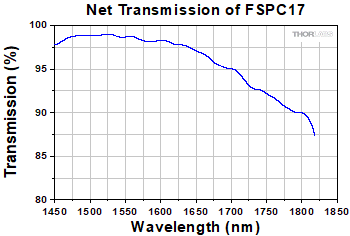
Click to Enlarge
Click Here for Data
This plot shows the calculated transmission through the FSPC17 pulse compressor.
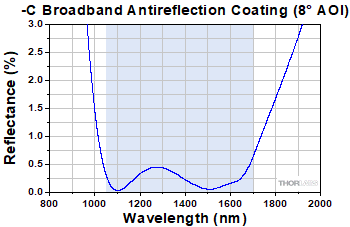
Click to Enlarge
Click Here for Data
The reflectance of a C-coated UVFS window (Item # WG40530-C) surface. The blue shaded region (1050 - 1700 nm) indicates the wavelength range where the -C coating has an average reflectance of <0.5%.
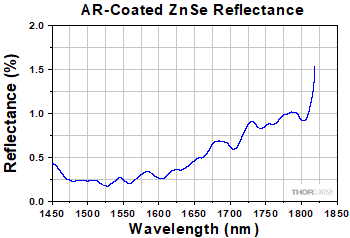
Click to Enlarge
Click Here for Data
This plot shows the reflectance off of one surface of the ZnSe prisms used in the FSPC17 pulse compressor.
How the Femtosecond Pulse Compressor Improves Image Contrast
When laser pulses are sent into a multiphoton microscope without dispersion compensation, the pulse experiences positive or negative dispersion depending on wavelength and the transmitting material as it propagates through the optical elements in the microscope. Due to the combination of glasses that are used in most microscope systems and objectives, laser pulses typically experience positive dispersion for wavelengths shorter than 1500 nm and negative dispersion for pulses longer than 1500 nm. In a positively dispersed pulse, the longer wavelengths contained within the pulse travel ahead of the shorter wavelengths (that is, red travels ahead of blue), while the opposite occurs for a negatively dispersed pulse (that is, blue travels ahead of red). In either case, the laser pulse at the sample is lengthened in duration, leading to reduced image contrast.
The FSPC Femtosecond Pulse Compressor applies negative dispersion to pulses with wavelengths in the range of 700 to 1050 nm, commonly used in two-photon microscopy systems. The FSPC17 Femtosecond Pulse Compressor applies positive dispersion to pulses with wavelengths in the range of 1450 to 1800 nm, which are used in certain three-photon microscopy systems. The microscope then applies positive or negative dispersion (depending on wavelength) to this pulse, and as a result, the pulse is short again at the sample, improving contrast.
The following illustration applies to positive dispersion compensation:
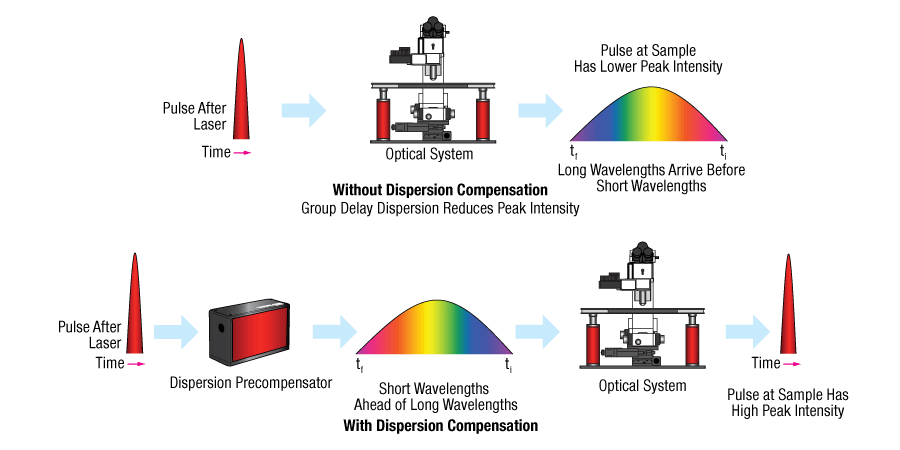
Experimental Flexibility of the FSPC Pulse Compressor
The FSPC pulse compressor provides negative group delay dispersion (GDD) for 700 - 1050 nm laser pulses, adjustable by rotating the knob on the side of the unit. Because the dispersion is adjustable, the unit is easily re-optimized when an objective, fluorescence filter, or other optical element is changed in the setup. The contour plot below shows the achievable GDD values as a function of wavelength. It provides a conversion between the prism displacement (shown on the display) and the dispersion applied to the pulse. (The prism displacement magnitude is defined by a calibration procedure, which is detailed in the manual.)
| Posted Comments: | |
Dave W
(posted 2024-12-13 12:05:05.773) Looking for feasibility and quote on a custom version for 395-540 nm range. We are using BiBO for SHG from a Chameleon Ultra 2, which is then used for SHG from a liquid interface. tdevkota
(posted 2024-12-16 09:25:20.0) Thank you for contacting Thorlabs. I have contacted you directly to discuss the feasibility of your custom request. Clayton Moss
(posted 2024-07-22 14:13:31.6) What is the median total optical beam path length for the FSPC? I couldn't find a value in the manual, my estimate is about 0.85 m. cdolbashian
(posted 2024-07-29 02:06:34.0) Thank you for reaching out to us with this inquiry. The median path length is indeed approximately 850mm. Biao-Feng Zeng
(posted 2022-12-05 08:00:52.89) I want to know whether the wavelength range of FSPC can be expanded to be in the range of 600-1100 nm. jdelia
(posted 2022-12-05 03:28:19.0) Thank you for contacting Thorlabs. I have contacted you directly to discuss the feasibility of your custom request. |


Click to Enlarge
Figure G1.1 Dispersion Adjustment Knob and Readout
- Correct for Material Dispersion in the 700 to 1050 nm Wavelength Range
- Compatible with Two-Photon Imaging Lasers
- Adjustable Dispersion Range: -12 500 fs2 to 0 fs2 at 800 nm
The pulse compressor supports operating wavelengths from 700 to 1050 nm, making it compatible with many common Ti:Sapphire laser systems including Coherent's Chameleon laser family. The range of possible dispersion compensation values as a function of wavelength are shown in the plot found in Table G1.2.
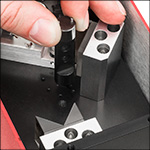
Click to Enlarge
Figure G1.3 Aperture Being Installed into Alignment Holes
To provide optimal GDD compensation for a wide range of microscope configurations, the dispersion can be adjusted by rotating a knob on the outside of the housing, shown in Figure G1.1. The knob controls the insertion of a prism into the beam. This feature helps ensure that performance is not compromised as the filters, objectives, or the laser wavelength are changed.
As the knob is rotated, a display shows how far the prism has been inserted. Higher values correspond to more glass in the beam path and hence more positive dispersion. The side of the unit contains a female 3.5 mm audio jack, which outputs a voltage that is proportional to the prism displacement for use as a diagnostic. A plot that converts between the prism insertion and dispersion is available in the Group Delay tab.
Installation
The femtosecond pulse compressor should be placed in the beam path between the laser and the microscope. Two beam heights are supported: 4.75" (120.7 mm), for Coherent's Chameleon™ lasers, and 4.25" (108.0 mm), for other common commercial lasers. The beam height is set by a base plate that is included with the unit. To set the beam height at 4.25", remove the base plate by unscrewing three bolts compatible with a 9/64" hex key or balldriver. Three CL5 and three CL8 Table Clamps are included for securing the pulse compressor to the optical table.
When the pulse compressor is first installed, it is necessary to align the input and output beams. We provide two custom-built apertures for initial alignment; one is shown being installed in Figure G1.3. The manual contains detailed alignment instructions. All internal optical elements are prealigned at Thorlabs before the unit is shipped.

- Correct for Material Dispersion in the 1450 to 1800 nm Wavelength Range
- Adjustable Dispersion Range: +750 fs2 to +4000 fs2
- 30 mm Cage Plate Compatible
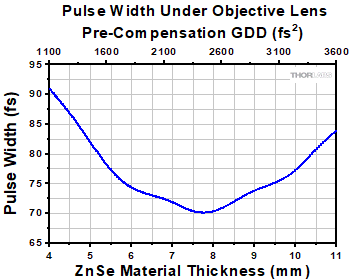
Click to Enlarge
Click here for Data*
Figure G2.3 The pulse width under the objective lens of a microscope is shown as a function of the ZnSe prism insertion (plus an addtional 6 mm of fused silica). The pre-compensation GDD values are given on the top-axis. Pulse widths without using the FSPC17 compressor were on average 62 fs before entering the microscope and then 111 fs under the microscope's objective.
The FSPC17 Pulse Compressor supports operating wavelengths from 1450 to 1800 nm, and is suitable for pairing with lasers designed for 3 photon microscopy in the 1.7 μm band. The compressor provides positive, or normal, dispersion pre-compensation by adjusting the distance the input light pulse travels through a set of ZnSe (zinc selenide) prisms. The wavelength range makes it ideal for compensating for dispersion in three-photon microscopy systems that use an excitation wavelength of 1650 nm, which often suffer from anomalous, or negative, group delay dispersion (GDD). The range of possible dispersion compensation values as a function of wavelength are shown in the plot found in Table G2.1.
To demonstrate the compressor's ability to reduce pulse width broadening, measurements were taken with the FSPC17 compressor installed in the beam path between Thorlabs' previous-generation FSLOPAX1 laser and a multiphoton microscopy system; the results are shown in Figure G2.3*. In these measurements, the compressor reduced the 1650 nm pulse width duration as measured under the objective lens of the microscope by about 37%.
To provide optimal GDD compensation for a wide range of microscope configurations, the dispersion can be adjusted by rotating a knob on the outside of the housing. The knob controls the insertion of the ZnSe prism into the beam. This feature helps ensure that performance is not compromised as the filters, objectives, or the laser wavelength are changed. The net dispersion of the system also includes the two fused silica windows (Item # WG40530-C) whose total 6 mm of glass thickness and anomalous dispersion in this range (-41 fs2 per mm) serve to reduce the minimum amount of GDD accessible with the FSPC17 compressor. If a user finds that the compressor does not have the dispersion range necessary to compensate for their application, additional glass windows can be added in lens tubes to either reduce (fused silica windows such as Item # WG40530-C) or increase (ZnSe windows such as Item #
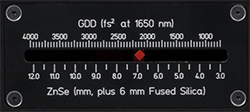
Click to Enlarge
Figure G2.2 GDD and Prism Insertion Scale and Indicator
The GDD is determined by the contribution of the adjustable ZnSe path length and fixed path length of the 6 mm thick fused silica windows.
As the knob is rotated, an indicator moves along the groove on the side of the unit showing the calibrated GDD value at 1650 nm (top axis) for the amount of ZnSe prism material the light pulse traverses (bottom axis), as shown in Figure G2.2.
Installation
The pulse compressor should be placed in the beam path between the laser and the microscope. The internal optics are pre-aligned and opening the unit is not necessary; only the input beam will need to be aligned to one of the ports on either side of the unit. To aid in alignment, horizontal and vertical marks indicate port center. Additionally, 4-40 tapped holes around both ports can be used to attach 30 mm cage components for aligned fixtures. The pulse compressor can be mounted to pedestal pillar posts by the two 8-32 threaded holes on the bottom of the device. Slots along the side of the housing can also be used to secure the device with CL4 (three are included) or CL5A clamps.
Note: The optics inside the FSPC17 pulse compressor are made from ZnSe, a hazardous material with low hardness. Additional care should be taken not to damage the prisms to prevent the formation of ZnSe dust. Handling of the ZnSe prisms is not required for the normal operation of the device. For your safety, please follow all proper safety precautions should you need to handle these optics including wearing gloves and thoroughly washing your hands afterward. Thorlabs will accept the FSPC17 Pulse Compressor back for proper disposal. Please contact Tech Support to make arrangements for this service.
*The data set is courtesy of Dr. Raluca Niesner and Anne Bias, Institute of the Leibniz Association, Deutsches Rheuma-Forschungszentrum (DRFZ), Berlin, Germany.
 Products Home
Products Home














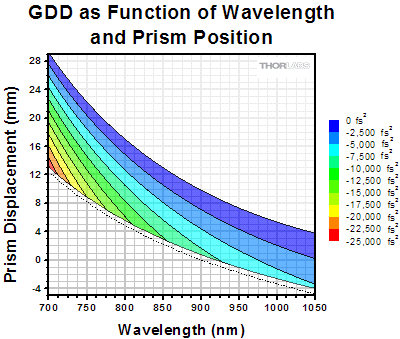
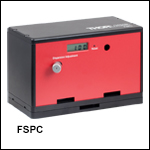
 Zoom
Zoom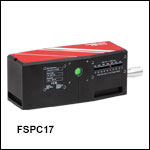
 Femtosecond Pulse Compressors
Femtosecond Pulse Compressors